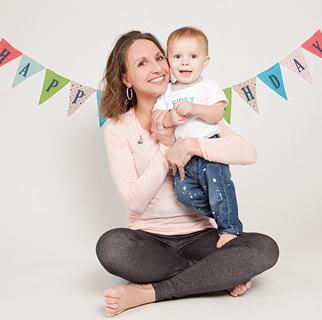The Growing Child: 1-Year-Olds
After a baby's first birthday, the rate of growth begins to slow down. The baby is now a toddler and is very active.

What can my baby do at this age?
As your baby continues to grow, you will notice new and exciting abilities that develop. Babies may progress at different rates, but these are some of the common milestones your baby may reach in this age group:
Walks alone by 15 months, then starts to run
Can stop, squat, then stand again
Sits down on small stool or chair
Climbs stairs while holding on
Dances with music
Plays with push and pull toys
Can build towers out of blocks
Throws a ball overhand by 18 to 24 months
Puts 2- to 3-piece puzzles together
Scribbles with crayon or pencil and may imitate drawing a straight line or circle
Mostly feeds self with fingers
Starts to feed self with spoon
Drinks well from cup
Can help with dressing and may be able to undress simple clothes (such as clothes without buttons or zippers)
First molar (back) teeth appear
Takes one afternoon nap
May sleep 10 to 12 hours at night
What can my baby say?
Speech development is very exciting for parents as they watch their babies become social beings that can interact with others. Every baby develops speech at his or her own rate, but these are some of the common milestones in this age group:
Imitates animal sounds and noises
At one year, says 4 to 6 simple words
At 18 months, says 10 to 15 words
By 18 to 24 months, uses simple phrases or 2-word sentences such as "Mommy up"
By 2 years, says 100 or more words
Asks "What is…?"
Uses negative phrases such as "No want"
What does my baby understand?
By about 18 months of age, children start to understand symbols. This is the relationship of objects and their meanings. Children may progress at different rates, but these are some of the common milestones children may reach in this age group:
Waves bye-bye and plays pat-a-cake
By 18 months understands 1-step questions and commands such as "Where is the ball?"
By 24 months understands 2-step questions and commands such as "Go to your room and get your shoes."
Understands object permanence. This means that a hidden object is still there.
Understands the cause and effect relationship better
Likes to explore drawers and boxes to see what is inside
Make-believe play increases. For example, the child may imitate housework or feed a doll.
Recognizes own face in mirror
Can point to body parts such as nose, hair, eyes when asked
Starts to understand use of certain objects such as the broom is for sweeping the floor
May ask for parent's help by pointing
How does my baby interact with others?
As children start to walk, they may begin to show independence and will try to walk further away from the parent, but will return. Separation anxiety and fear of strangers may lessen, then return at about 18 months. Every child is unique and will develop different personalities, but these are some of the common behavioral traits that may be present in your child:
Plays along side others without interacting. This is called parallel play.
May start clinging to parents around 18 months
May start to say "no" more often to commands or needs
May have temper tantrums
May use a blanket or stuffed animal as a security object in place of the parent
How to help increase your baby's learning and emotional security
Consider the following as ways to foster the emotional security of your 1-year-old:
Give your child toys that can be filled and emptied and toys for imaginary play.
Give your child simple 2- to 6-piece puzzles and balls of all sizes.
Help your child build towers of blocks.
Encourage your child to "help" you with household tasks.
Give your child paper and large crayons to scribble and draw.
Talk to your child with clear simple language about what you are doing.
Use the correct names for objects, even if your child does not. For example, your child might say "wa-wa," and you say "Water, that's right."
Expand your child's sentences. If your child says, "Want cookie," you say, "Do you want another cookie?"
Read to your child every day using picture and story books.
Feed your child at family mealtimes.
Provide consistent firm, appropriate discipline without yelling or hitting.
Connect with us:
Download our App: